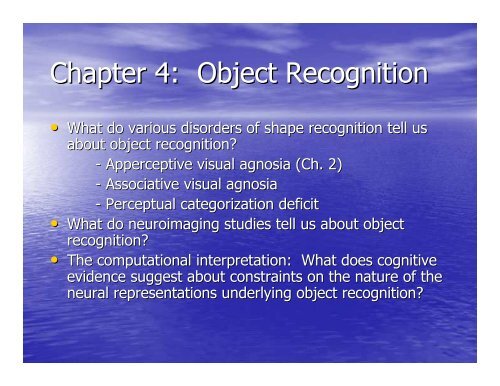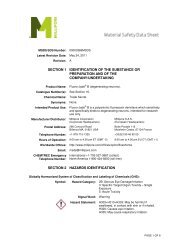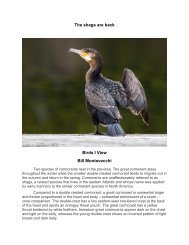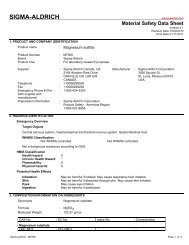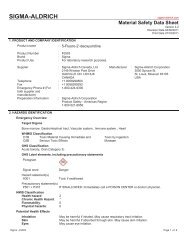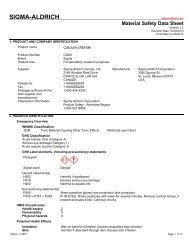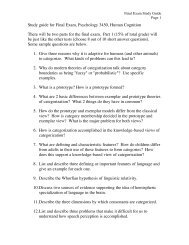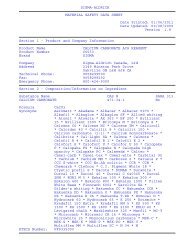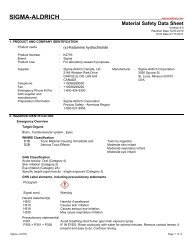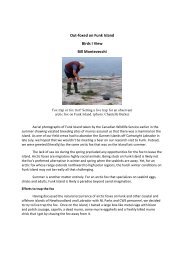Chapter 4: Object Recognition - Play Psych Mun
Chapter 4: Object Recognition - Play Psych Mun
Chapter 4: Object Recognition - Play Psych Mun
Create successful ePaper yourself
Turn your PDF publications into a flip-book with our unique Google optimized e-Paper software.
<strong>Object</strong> <strong>Recognition</strong>• Dr. Harley has filledyou in on theneuroscience side ofthe miracle…Farah (2000) – Fig. 4.1
Visual Agnosias• Visual Agnosia: : A blanketterm for impaired visual objectrecognition following braindamage when elementaryvisual functions (acuity, visualfields) are adequate.• Apperceptive visual agnosia:Inability to group the localfeatures into a coherentperceptual representation (Ch2)• Associative visual agnosia:Inability to recognize visuallypresented objects, despitehaving a coherent perceptualrepresentation
Visual Agnosias: : Copying anddrawing from memory.Apperceptive agnosiaAssociative agnosiaCopyingCopyingMemory
Associative visual agnosia: : Criteria• Patients can form percepts (do perceptualgrouping) unlike apperceptive agnosia patients.• They can see an object well enough to describeits appearance, to draw it, or to succeed in asame/different test of appearances.• They have difficulty recognizing visuallypresented objects (can’t t name or sort objects bycategory)• They can demonstrate knowledge of objectsfrom other sensory modalities
Associative agnosia behavior: Animpairment of shape perception• They can copy complex objects.BUT their copying behavior isabnormal – HJA took 6 hours to dothe cathedral.• They are very sensitive to visualquality of stimuli. They recognizereal objects better than linedrawings; face recognition ofunfamiliar people is impaired bychanging lighting conditions.• They make visual shape recognitionerrors; they might call a baseballbat, a paddle, knife, baster, , etc.
Associative Visual Agnosia• The human analog of the IT-lesionedmonkeys.– They fail to recognize objects because theyfail to represent shape normally.• Slow, slavish copying• Sensitivity to visual quality of the stimuli• Visual shape errors
Regions of brain damage associatedwith different types of visual agnosia• Apperceptive Agnosia:Diffuse damage to theoccipital lobe andsurrounding areas• Associative Agnosia:Occipitotemporalregions of bothhemispheresFrom Banich (2004)
Perceptual categorization deficit• Difficulty recognizingobjects viewed fromunusual perspectives oruneven illuminationconditions (Warrington &Taylor, 1973)• Initially assumed toreflect an impairment ofviewpoint-invariant invariant objectrecognition
BUT: Is Perceptual CategorizationDeficit really about loss of shaperepresentations?• Not impaired in the real world.• Not impaired under all viewing conditions per se.• Mainly impaired when matching an USUAL to anUNUSUAL view; normal people have similar, lessserious, type of difficulty.• Associated with unilateral RH lesions, usually inparietal cortex, not inferotemporal cortex
Perceptual categorization deficit• Demonstrates value of examiningevidence carefully and trying to link it withwhat is known to see whether patterns fitor not.• In this case, the pattern differs greatlyfrom other visual agnosias.
Functional Neuroimaging Studies:• Goal of PET, fMRI studies: : To localize thepsychological process(es) ) of interest• Research design: : Measure brain activity in atleast two conditions: a control (baseline)condition and an experimental condition.– <strong>Psych</strong>ological process localized by subtracting brainactivity in the control (baseline) condition from brainactivity in the experimental condition.
PET Imaging (Posner(&Posner & Raichle, , 1994)Upper row: Control PET scan(resting while looking at staticfixation point) is subtracted fromlooking at a flickeringcheckerboard stimulus positioned5.5°from fixation point.Middle row: Subtractionprocedure produces a somewhatdifferent image for each of 5subjects.Bottom row: The 5 images areaveraged to eliminate noise,producing the image at the bottom.
Where in the brain does visualrecognition occur?• Visual recognitionlocalized to theposterior half of thebrain – really?• Whoops!!! Why didthese studies fail tolocalize visualrecognition?• Poor methodology!
Neuroimaging methods: Thesubtraction technique• Using the subtraction technique effectivelyrequires that the baseline and experimentalconditions differ only in the process of interest.– Requires careful logical analysis of the task todetermine the best comparison conditions.• If there are many differences between thebaseline and experimental conditions, it isdifficult to interpret the results of the study.
Neuroimagining Studies of <strong>Object</strong><strong>Recognition</strong>: Comparing baseline andexperimental conditionsSequence of trial events– Fixation point– Stimulus presentation– Task (two types)Passive Viewing Task:Are stimuli comparable(e.g., size, complexity)Mind is not a vacuumActive Viewing Task:What is task?What is response?
Sergent et al (1992a):Active viewing task.• Baseline condition- View fixation point• Experimentalcondition- View fixation point- See line drawing ofobject- Decide whether theobject is living or non-living- Make Yes/Noresponse
Localizing Visual <strong>Recognition</strong>• Is human visual recognition supported byone general purpose recognition system orare there specialized modules forrecognizing objects, faces, printed words?• Good functional neuroimaging studies doexist to test these possibilities and will bediscussed in <strong>Chapter</strong>s 5 & 6.
Constraints on the nature of shaperepresentations in IT: Coordinate systems• Cannot be simple viewer-centered orenvironmentally-centered– IT cells respond to a given shape overchanges in the position, size, and pictureplane orientation of object– Impairments of IT lesioned monkeys:suggest they have lost abstract shaperepresentation
Constraints: Coordinate systems cont.• Two possibilities:1. <strong>Object</strong>-centeredcenteredcoordinate system2. A cluster of multipleviewer-centered objectrepresentations plusthe ability to transformone representation toanother as necessary(a la Multiple Viewsmodel of Tarr, , 1995).
Constraints: Coordinate systems cont.• Farah prefers the Multiple Viewer-Centeredrepresentation option because:– Position, size, and orientation invariance shown by ITcells is not perfect; consistent with some views beingbetter learned than others.– IT neurons can selectively learn arbitrary associationsbetween pairs of stimuli, a prerequisite for derivinginvariance from viewer-centered representations.– Consequently, because cell activity takes time todecay and because seeing different views of an objecttends to be clustered in time, the correlation(association) between several different retinotopicviews of the same object could be learned.
Constraints: Primitives and Organization• Primitives– Cannot be contours– Could be either surface-based (2D) orvolume-based (e.g., 3D geon-like parts).• Organization– Hierarchical? We really don’t t know muchabout how multipart objects are represented
Constraints: ImplementationSymbolic Model vs Neural net• Is a perceptual representation created and thencompared to a memory representation? (Impliesthat the memory representation can be destroyed,yet the perceptual representation remains intact).Unlikely, since no such evidence exists.• Does the input get coded and recoded in asuccession of neural nets as it is processed throughthe visual system? (Implies that impairment in testof object memory is associated with perceptualimpairment). Yes, this seems true in associativeagnosia.
Constraints: Implementation• Distributedrepresentation morelikely than localrepresentation– Single unit recording– Graceful degradationfollowing damage toIT


